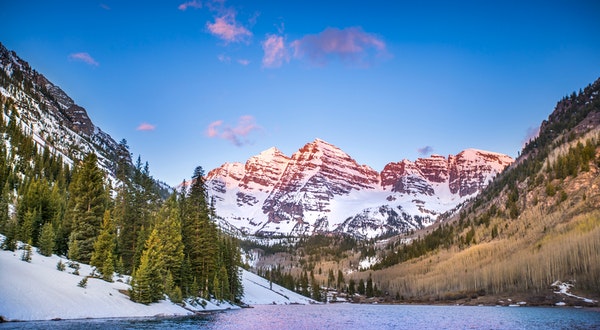Increased demand for beach and outdoor travel and more flexible work schedules have all but eliminated the shoulder and off-seasons in some popular destinations.
share this article
Justin Todd used to be able to predict when business would be slower. Having been in the hospitality industry in Aspen, Colorado, for 15 years, he knew that the period between the snow going to slush and the wildflowers blooming would see a lull. From mid-April to early June, many Aspen properties, including Aspen Meadows Resort, where he is the general manager, would shut down—there wasn’t enough business to justify staying open. Companies often used that window to make repairs, deep clean, and complete projects. It was also a time for staff to decamp for their own vacations and locals to have their community all to themselves.
However, since the beginning of the pandemic, that period of rest has been disrupted.
“Things are definitely busier now,” said Todd of shoulder season, adding that his resort is currently staying open year-round—occupancy rates above 70 percent for what was previously the slow season made it an easy choice from a business perspective.
Aspen isn’t alone. Across the country, destinations have noticed a shift in traditional travel seasons. Many other places that have historically opted to close during the slower periods, like the Ritz-Carlton Lake Tahoe, are now staying open all year because there’s so much more demand.
“The length of the off-season has shortened greatly,” said Linda Bendt, owner of Minnesota-based travel agency Pique. “In many places, the lines have blurred. Travelers are looking at destinations differently.”
Increasingly, interest in vacation spots has become divorced from weather forecasts. According to Wendy Burk, founder of La Jolla, California–based travel agency Cadence, “Availability and safety are the two biggest factors now.”
“There’s a scar tissue travelers have from this pandemic era, and it’s not likely to heal that quickly,” Burk said. “Windows of opportunity to travel can close as quickly as they open. When you have the chance to go, and the option is safe and available, you go.”
Jan Freitag, national director of hospitality analytics at the information and analytics company CoStar Group, credits work-from-anywhere policies for part of the shift. It’s allowing people to travel more frequently and for longer.
“It used to be that when you looked at the data, there was a distinct high-water mark in June and July—hotel occupancy nationally was over 70 percent and then would drop off at the end of summer,” Freitag said. “In 2021, those high numbers remained robust through October. And that was with less business travel—those numbers are probably just leisure travelers.”
Nancy Lien, a public relations manager at Expedia Group (which encompasses more than 200 websites, largely travel fare aggregators and travel metasearch engines, such as Expedia.com, Vrbo, Hotels.com, Hotwire.com, Orbitz, Travelocity, Trivago, and CarRentals.com), said that data her company has compiled is consistent with CoStar’s findings.
“Looking back at lodging data across Expedia and Hotels.com for September 2021, we can see travel demand remained strong, and so did lodging prices, which goes against the seasonal trends we used to see prior to the pandemic,” Lien said.
One example, she noted, was that lodging demand for destinations in Mexico and the Caribbean was up around 200 percent in September 2021 compared to September 2019. Lien added that the places seeing the most significant increase of shoulder season travelers are those with access to the outdoors, particularly national parks and beaches.
“Top destinations are seeing a double-digit increase in hotel demand compared to prepandemic—spring shoulder season might be gone in some places,” Lien said, adding that it’s a trend we’ll likely see continue this fall.
According to Lien, hotels in places like Oʻahu, Maui, the Florida Keys, Punta Cana in the Dominican Republic, and all major coastal destinations in Mexico are experiencing significant demand compared with 2019, regardless of the time of year. Similarly, lodging near national parks—even during frigid winter months in parks such as Mount Rushmore and Yellowstone—is well above prepandemic levels.
The prolonged season can prove to be both a help and a hindrance to destinations. More travelers usually equate to more revenue. But in destinations like Park City, Utah, and Jackson Hole, Wyoming, where the summer and winter seasons can be hectic, the shrinking off-season means the workers don’t get much of a break, which is particularly problematic when there’s already a labor shortage. It also means locals have to contend with a nonstop barrage of tourists year-round.
The shoulder and off-seasons have also been a reliable time for travelers to score deals and visit a destination when few others are there. But the more travelers there are, the higher the demand— thus, hotels can often charge more (not to mention that inflation has also driven up travel prices).
Where to find fewer off-season crowds
For those looking for shoulder and off-season trips and deals like those of old, timing and flexibility are key.
According to Expedia’s 2022 Travel Hacks report (released in November 2021 in collaboration with the Airline Reporting Corporation), January is the cheapest month to depart on domestic flights, yielding around 10 percent in savings (OK, so not for this year, but noted for 2023 and beyond). August is the most affordable time to travel abroad (approximately 20 percent cheaper). Similarly, the lowest average daily rate for lodging tends to occur on Mondays, where travelers could save more than 15 percent versus staying on Friday, the most expensive day. For international trips, staying on a Tuesday rather than Thursday saves nearly 10 percent.
In terms of where you go, Lien noted that destinations like Lake Powell (in Utah and Arizona), Glen Canyon National Recreation Area in Utah, and Boulder, Colorado, are good, cheaper alternatives to national parks like Yosemite and Zion. Orange County and San Diego in California, Fort Lauderdale and Daytona Beach in Florida, and Costa Rica tend to be more affordable than Mexico and Caribbean beaches for those looking for a sand-and-sun vacation.
While it’s impossible to predict if the off-season will entirely be a thing of the past in the years to come, Freitag did note one wrinkle likely to nudge the calendar back to normalcy: the school year.
“As more schools return to consistent in-classroom learning, more people will be connected to the high seasons again, driven by the school calendar,” Freitag said. “We’ll have to see how it plays out.”
The reopening of more countries might also reduce pressure on destinations. But, if you ask Burk, she’ll tell you her company believes it’s “a trend that will continue as the world opens up.”
>>Next: Where to Go in 2022













